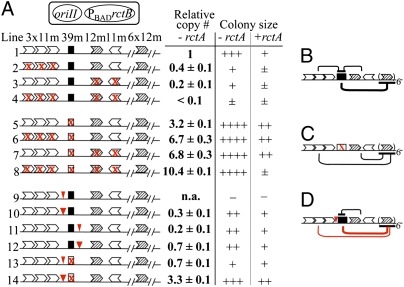Fig. 3.
Regulatory activity of incII elements in cis. (A) A two-plasmid system was used where one plasmid supplied the incII elements in cis to oriII and another (pTVC11) supplied RctB, using 0.2% arabinose. The oriII regions (with and without rctA) were cloned in a R6Kγ origin plasmid and the plasmids were maintained in CVC553. Plasmids in lines 1–14 carrying rctA were derivatives of pTVC210, and the corresponding plasmids lacking rctA were derivatives of pTVC211. Mutated sites are marked with red crosses, and 5- and 10-bp insertions as narrow and wider red triangles, respectively. The insertions were at chrII coordinate 444 in plasmids 9, 10, 13, and 14, and at coordinate 496 in plasmids 11 and 12. The plasmids were electroporated into BR8706/pTVC11, and colony sizes of the transformants were recorded as very large (++++) to barely growing (±). In some cases no colonies were obtained (−). The copy number of oriII plasmids was measured in the set without rctA, except for plasmid 9 (n.a., not applicable), where no transformants were obtained. The copy number of 1 is about 4× more than the chrII copy number (Experimental Procedures). (B –D) Models. The lines above the map of the oriII region show functional interactions among the incII elements, and the lines below, the interactions with origin iterons. Thicker lines signify stronger interaction, and red lines the interactions that are enhanced upon the 5-bp insertion. The models show the dual role of incII iterons as facilitators of replication by restraining the 39-mer and as inhibitors of replication by interaction with the origin (B). In the absence of 39-mer, iterons act only as inhibitors and additively (C). The 5-bp insertion changes the relative disposition of the three 11-mers so that they fail to interact with the 39-mer but become better disposed to inhibit the origin (D).

